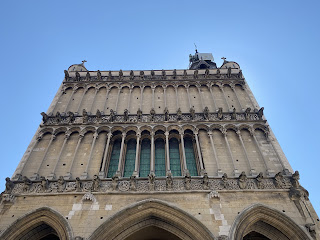Dijon proved to be an unexpected surprise. It was really just supposed to be a layover town and the easiest stopover to get from one place to another. But, I really love this city. Unlike many of the other French towns I’ve been to, the old town is relatively new - most of the buildings are from the 16th and 17th Centuries. There are wide streets here without many cars, so it is a walking town and one that is filled with shops of all kinds - national chains as well as Mom and Pop shops. Anything you could possibly want is here. There are also a plethora of museums scattered throughout filled with artwork and sculptures. I visited two or three without paying an admission price. There is a city bus (the shape and size of a really cool looking van) that drives all over the town and takes you from one place to another, also free of price.
For a relatively small town, there are many old churches. Several of them have been decommissioned and have been put to use in other ways. One is a restaurant, another a museum, one was turned into the local library, and the last one that I came across is a theater - there still may be others that I did not discover during my brief time here.
On every building that has some historical value, there is a plaque that explains when it was built, who built it, what purpose it served, who owned it over the years, how it might have changed or been remodeled, and what other purposes it may have served, etc… It was fascinating to read each building’s history.
Dijon mustard is named after this town and was created in 1336 for the table of King Philip VI. It was slightly different in taste from what we now call Dijon Mustard. Originally, it had a vinegar base. In the 17th Century Dijon was granted exclusive rights in France for making it, similar to Champagne. If Champagne is made somewhere else, outside of Champagne, it can’t be called Champagne but must be called Sparkling Wine instead. In 1856, the Dijon mustard we are familiar with was created; the vinegar base was exchanged for something called verjuice, the more acidic juice from unripened grapes. Today, however, that verjuice is generally replaced with white wine or a mix of vinegar, water and salt, to imitate the well-known flavor of Dijon mustard. Not to burst anyone’s bubble, but since 2009, Dijon mustard is no longer manufactured and packaged in Dijon and 80% of the brown mustard seeds used come from Canada. This is unlike Champagne that kept its rights from being used elsewhere. Grey Poupon - the Dijon mustard brand that we all know and love did originate in Dijon in 1866 but is now made throughout Kraft Foods’ plants around the world.
The Burgundy region (the area that includes Dijon) is well-known for Truffles, as well as wine (but what region in France isn’t?) I wasn’t able to book a tour with a “hunting” group to learn more. There was a tour going out on Sunday afternoon - not helpful for me. What I do know is that truffles are mushrooms of a high and dense flavor, sought after by chefs the world over and that Black Truffles which more often come from the southern area of France in the Provence region, collected during winter, are the superior prize and can cost a ridiculous amount of money per pound (something like $400 per pound). White Summer Truffles are less intense in flavor, but are slightly cheaper (something like $350 per pound). Some chefs will only use Black Truffles and other chefs find the White Truffle more versatile.
As I mentioned there are a number of churches in Dijon and wonderful architecture of buildings that go back to the 16th and 17th Centuries. I’ve posted pictures below.

















































No comments:
Post a Comment